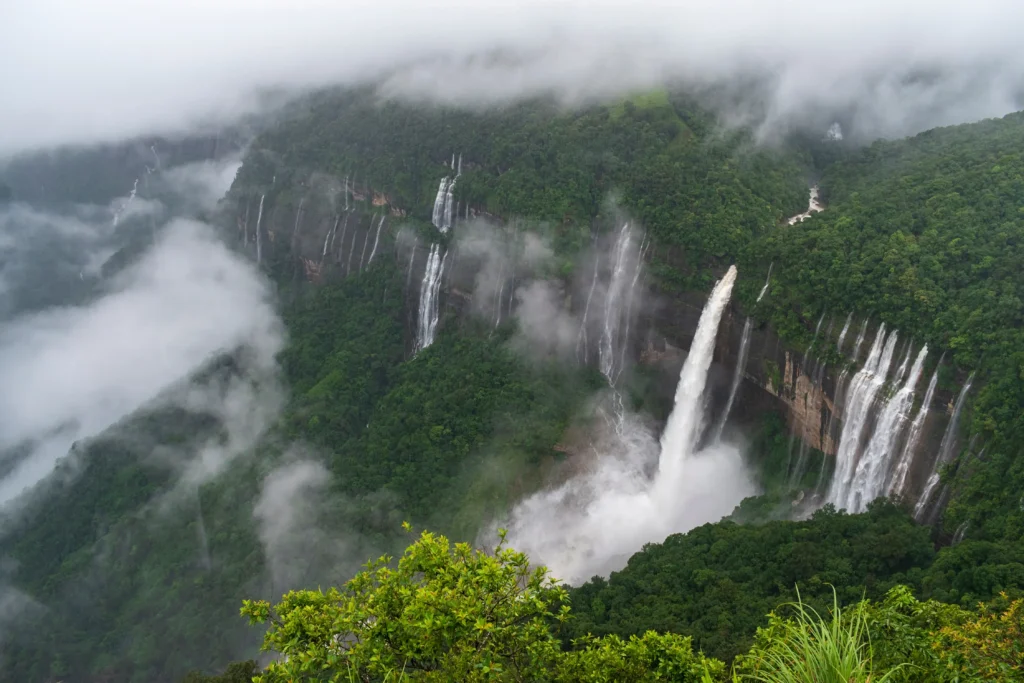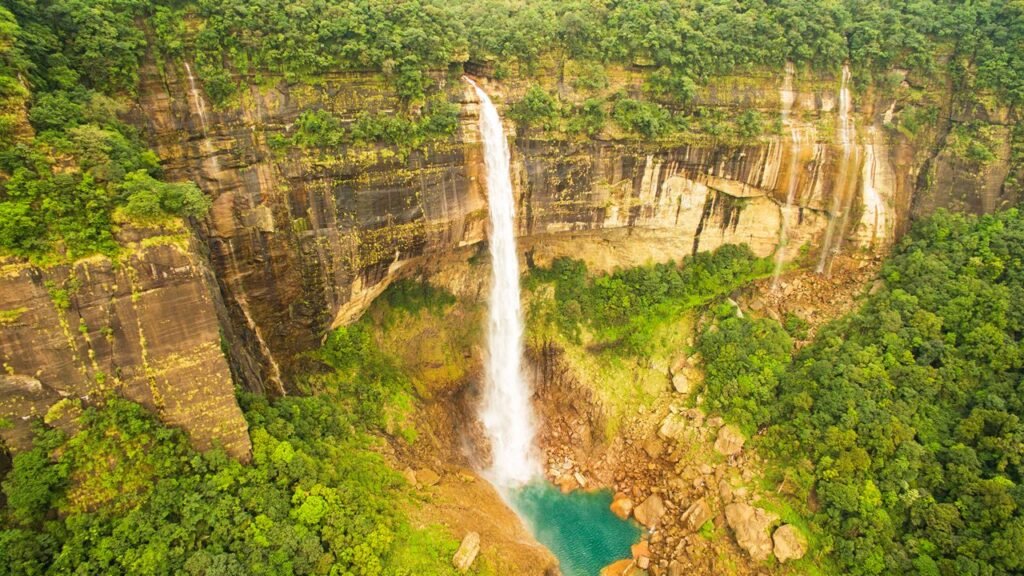Nohkalikai Falls, nestled in the lush hills of Meghalaya near Cherrapunji, is India’s tallest plunge waterfall, with a staggering drop of 335 meters (1,115 feet) into a turquoise pool framed by mist and greenery. Renowned for natural beauty, this awe-inspiring site holds deep cultural significance among the Khasi people and draws travelers from around the world.
The Tragic Legend Behind Nohkalikai
Nohkalikai means “the leap of Likai” in the Khasi language. According to folklore, Ka Likai was a widowed woman living in Rangjyrteh village who remarried for her infant daughter’s sake. Driven by jealousy, her second husband killed the child, preparing her flesh in a meal. Exhausted and unaware, Likai ate the meal, only to realize the horror after finding a severed finger. Distraught, she plunged off the edge of the waterfall, giving the falls their poignant name.
Key Details:
| Aspect | Details |
|---|---|
| Location | Cherrapunji, East Khasi Hills, Meghalaya, India |
| Waterfall Height | 340 meters (1,115 feet) |
| Type | Tallest plunge waterfall in India |
| Visiting Hours | 9:00 AM to 5:00 PM |
| Best Time to Visit | June-September (Monsoon), October-November (Post-monsoon, clearer skies) |
| Entry Fee | INR 10-20 per person; INR 10-20 extra for camera usage |
| Trekking & Activities | Trek to base (moderate); photography; explore viewpoints; picnic; local shopping |
| Recommended Duration | 1-2 hours at viewpoint; trek to base (up to 4 hours) |
| Accessibility (By Air) | Shillong Airport (80 km, cab fare: INR 2,000–3,000) |
| Accessibility (By Rail) | Guwahati Railway Station (150 km, cab fare: INR 3,000–4,000) |
| Accessibility (By Road) | Rentable cab/bus/bike; Shillong-Cherrapunji (1–2 hours, cab: INR 1,500–2,000) |
| Parking Fee | Approx. INR 10 per hour |
| Local Attractions | Tlai waterfalls, Seven Sisters Falls, Living Root Bridges, Thangkharang Park, Mawlynnong |
| Safety Tips | Slippery paths during monsoon; guide recommended for trek to base |
| Shopping & Food | Souvenir shops, food stalls, local handmade crafts, honey, spices |
Cultural Significance and Khasi Traditions
Beyond its tragic origin, Nohkalikai embodies core Khasi beliefs. The local community sees the falls as a spiritual symbol, nature’s power and an ancestral connection. Rituals and prayers are customary before visiting, and respect for the environment is paramount. Preservation efforts and sustainable practices by locals help protect the area’s beauty for future generations.

Location and Route
Nohkalikai Falls is about 7.5 km from Cherrapunji (Sohra) in Meghalaya, approximately 80 km from Shillong.
- By Air: Shillong Airport is the nearest, with cab/bus rides to Cherrapunji taking 2-3 hours.
- By Rail: Guwahati Railway Station is 150 km away; cabs or buses continue to Cherrapunji in 4-5 hours.
- By Road: The area is well connected, with scenic drives through misty hills and valleys. Cabs, buses, bike rentals, and even walking from Cherrapunji are popular.
Things to Do at Nohkalikai
- Panoramic Viewing: The viewpoint offers a striking panorama of the falls plunging from a sheer cliff into an emerald pool, especially spectacular in the monsoon when flow is at its peak.
- Trekking: Adventurers can trek down to the base, passing lush forests and boulders, a 4–5 hour round trip recommended with guides due to the steep and slippery trails.
- Photography & Picnics: The rich landscape and mist create ideal photography settings. The area’s tranquility makes it perfect for picnics.
- Explore Nearby: The journey includes other falls like Tlai waterfalls and the living root bridges that Mekgalaya is famous for.
Tourism Impact and Revenue
Nohkalikai Falls is a major tourism draw for Meghalaya, forming a vital part of the state’s hospitality and transportation economy. Thousands visit annually, especially during monsoon and holiday seasons. The influx sustains local businesses, restaurants, hotels, trekking guides, and artisans who showcase Khasi crafts and cuisine. Efficient management of tourism here sets benchmarks for eco-tourism in Northeast India.
Environmental and Cultural Preservation
Conservation efforts protect the fragile ecosystem around the falls. Local authorities and grassroots organizations promote regulated trekking, waste reduction, and eco-friendly behavior. The falls’ legend fuels awareness, underscoring the need to balance visitor enjoyment with nature’s long-term preservation.
Best Time to Visit
- Monsoon (March–October): The falls are at their full might, draped in clouds, with occasional fog obscuring views.
- Winter (November–February): Clearer skies, trekking is safer, and the area sees fewer crowds.
Both periods offer unique perspectives, from thundering cascades to tranquil, emerald pools.
FAQs about Nohkalikai Falls
Where exactly is Nohkalikai Falls located?
Nohkalikai Falls is located near Cherrapunji in the East Khasi Hills district of Meghalaya, northeastern India, about 7.5 km from the town center.
What makes the falls famous?
The falls are not only India’s tallest plunge waterfall but also shrouded in a dramatic local myth that adds cultural depth to its natural grandeur.
How can tourists reach Nohkalikai Falls?
Visitors can reach by air via Shillong airport, by train to Guwahati, or by road from Shillong/Cherrapunji with various transport options.
What is the best time to visit Nohkalikai Falls?
Monsoon is when the waterfall is most powerful, but winter is better for trekking and clear photography.
Is it safe to trek to the base of Nohkalikai Falls?
It is a challenging trek, especially in the rainy season. Trekking with a guide and exercising caution is recommended due to slippery and steep trails.
Are there any nearby attractions?
Yes, visitors often explore other waterfalls like Tlai, Wei Sawdong, and the unique double-decker living root bridges in the Cherrapunji area.
How does the place reflect Khasi culture?
Nohkalikai is deeply embedded in Khasi folklore. Local rituals, respect for nature, and sustainability are integral, and visitors are encouraged to learn and engage respectfully.
What is the revenue impact of tourism at Nohkalikai?
The waterfall supports local livelihoods, from guides to hotels and souvenir shops, making it an economic pillar for many families.
Recent News and Developments
In 2025, Nohkalikai Falls drew international acclaim after conservation projects enhanced accessibility while preserving the ecosystem. State authorities, in collaboration with local groups, installed new safety railings at viewpoints and launched a digital ticketing system to manage visitor capacity and reduce environmental impact. The story of Ka Likai inspired cultural festivals aimed at promoting Khasi heritage and eco-tourism.
